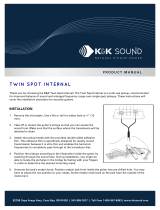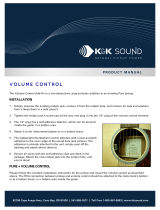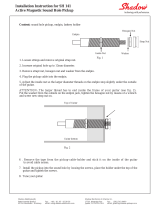Page is loading ...

TM
ONBOARD
BLENDER
USER’S GUIDE
WARNING!
WE STRONGLY RECOMMEND THAT YOU FAMILIARIZE YOURSELF WITH THE
PREAMP CONTROLS BEFORE YOU ATTEMPT TO PERFORM WITH THE ONBOARD
BLENDER. FAILURE TO DO SO COULD RESULT IN WAVES OF EAR-SPLITTING
FEEDBACK AT HIGH LEVELS. (see Quick Start on page 3.)

This fine instrument is equipped with a FISHMAN PREFIX™ ONBOARD BLENDER™.
Please read these instructions carefully. If you have any questions or problems,
please call our CUSTOMER SERVICE LINE at (978) 988-9665.
The ONBOARD BLENDER™ is a guitar mounted preamp that combines the sounds
from a supplied FISHMAN ACOUSTIC MATRIX™ under-saddle pickup and a preamp
mounted miniature electret condenser microphone.
The microphone, shock-mounted on the underside of the preamp chassis, captures the
elusive natural ambience and resonance of the guitar's sound chamber. The
ACOUSTIC MATRIX™ pickup delivers a clear, articulate sound with emphasis on string
definition and attack. When combined, the two signals produce a powerful and cohe-
sive acoustic guitar tone that is much greater than the sound of either microphone or
pickup alone.
The ONBOARD BLENDER™'s preamp module incorporates a unique "flip-top" battery
compartment for easy access. Levels are set by the master VOLUME and BLEND con-
trols. A variable NOTCH filter, shelving BASS & TREBLE, semi-parametric CONTOUR
and a PHASE switch are included for precise tone shaping and feedback control. The
ONBOARD BLENDER™ can be plugged into any instrument-level audio input with
excellent results.
THE PICKUP
The included ACOUSTIC MATRIX™ pickup is made with a unique co-polymer sensing
material available exclusively from FISHMAN. This technology is not available from
any other manufacturer. The sensing material exhibits a sensitivity and dynamic range
that far surpasses all other known materials. The ACOUSTIC MATRIX™ transducer is
a fully EMI shielded, multi-layer sandwich of co-polymer strips that run the length of
the pickup. This design allows the pickup to sense the motion of the entire saddle
length, providing superb string to string balance, as well as sensitivity to both the
strings and top of the instrument.
THE MICROPHONE
The microphone, in conjunction with PHASE, NOTCH and CONTOUR controls (see
page 6), will provide very high level sound reproduction before feedback. Conveniently
shock-mounted to the back of the preamp case, the microphone is acoustically isolated
inside the instrument, providing freedom of movement as well as minimal leakage from
other instruments on stage.
FISHMAN PREFIX™ ONBOARD BLENDER
2

ACOUSTIC GUITAR SYSTEM
3
QUICK START
To successfully combine microphone and pickup signals, it is best to start by
presetting the microphone EQ to control feedback, then mixing in the pickup.
The PREFIX™ ONBOARD BLENDER™ features three ways to control feedback;
a PHASE switch, NOTCH filter and semi-parametric CONTOUR controls.
Follow these steps to achieve a strong, feedback-free microphone response.
1. Before plugging in, set all controls as follows:
• NOTCH and VOLUME fully counter-clockwise
• All EQ sliders at center position
• BLEND slider at MIC position
2. Plug in the instrument (see THE PREAMP section) with your amplifier set as
desired.
3. Slo
wly increase the VOLUME until the guitar and speaker are approximately
the same level. Play the lower strings and flip the PHASE switch. Leave the
switch in the position that sounds the deepest and clearest. (See page 8)
4. Slo
wly increase the volume until the instrument starts to rumble or howl with
low to mid level feedback (100-200 Hz).
5. Adjust the NOTCH filter until the feedback is eliminated.
6. Slo
wly increase the VOLUME again, until you hear a squeal (high frequency
feedback).
7. Lower the CONTOUR Level all the way down. Slowly adjust the Contour
FREQUENCY slider until the feedback is eliminated. Raise the CONTOUR
Level slider (if possible) to just below the threshold of feedback.
8. Gradually mix in the pickup signal by adjusting the BLEND slider.
The pickup signal will add significant attack and definition to your sound.
9. Adjust the BASS and TREBLE controls as desired.
Please note that these controls will affect pickup signal only.
10.Double check the PHASE switch position until you find the clearest response.
11.Play your guitar as loud as you want.
See diag
ram on page 6

FISHMAN PREFIX™ ONBOARD BLENDER
4
PREAMP FUNCTIONS
BATTERY COMPARTMENT
Pull the small tab at the top
of the ONBOARD
BLENDER™ toward you. The
body of the preamp will
swing out, revealing the BAT-
TERY COMPARTMENT.
Insert a fresh 9V alkaline
battery.
MICROPHONE TRIM CONTROL
A small circular potentiometer is located on the underside of the preamp just
below the battery compartment. This control is used to calibrate the microphone
gain in relation to the pickup. To use this control, set the BLEND slider to the
center position and, with a small screwdriver, adjust the potentiometer until both
the microphone and pickup levels are balanced.
ENDPIN JACK
The ONBOARD BLENDER™ has no ON/OFF switch. It is turned on only when
an instrument cable is plugged into the endpin jack. To conserve the battery,
remove the instrument cable from the endpin jack when the unit is not being
used.
NOTE: Plug an instrument cable into the endpin jack before you plug into the
sound equipment. Doing so will prevent loudspeaker damage.
BATTERY LOW LED
When plugging into the endpin jack, the LOW BATTERY light will flash momen-
tarily, indicating that the power is on. When the LOW BATTERY light stays on, it
is time to change the battery.
CONTROLS
NOTCH FILTER
This is a fixed level, variable-frequency filter for eliminating feedback or
unwanted resonance. The affected frequency is variable from 50 to 900 Hz. The
GUITAR BODY
PREFIX™ SERIES PREAMP
MICROPHONE
TRIM
9V BATTERY

ACOUSTIC GUITAR SYSTEM
NOTCH FILTER is effectively off in the full counter-clockwise position.
VOLUME CONTROL
The VOLUME control affects both microphone and pickup. Goes from very quiet
to very LOUD.
BASS CONTROL
This is a boost/cut shelving tone control. This control affects the pickup signal
only. The center detent yields a flat response.
CONTOUR This is a wide-range semi-parametric filter. It may be used to
shape the instrument's tone or to control feedback (see pages 6 and 7). The
CONTOUR control affects both the pickup and microphone.
The CONTOUR Level slider controls the amount of boost or cut applied to the
selected Contour FREQUENCY. The center detent yields a flat response.
The Contour FREQUENCY slider determines the frequency band that is
boosted or cut by the CONTOUR Level control. The frequency is variable
between 250 Hz and 10 kHz.
TREBLE CONTROL
This is a boost/cut shelving tone control. This control affects the pickup signal
only. The center detent yields a flat response.
PHASE SWITCH
The PHASE switch compensates for acoustic phase differences that often occur
between instrument and speaker. It can be used as a tone filter at low volume
levels or a feedback filter at high levels. Whenever you play through a different
sound system or at a different venue, flip the PHASE switch several times and
use your ear to find the optimum setting.
BLEND CONTROL
This control determines the balance between microphone and pickup signals.
This control can be used as a feedback "escape hatch" if you ever need to
instantly shut off the microphone during a performance.
5

FISHMAN PREFIX™ ONBOARD BLENDER
6
SUGGESTED EQ SETTINGS
ANTI-FEEDBACK
Refer to page 3.
BRILLIANCE
If you are playing through an electric
guitar amplifier or have dead strings on
the instrument, you can brighten up
your sound by setting the Contour FRE-
QUENCY slider to 10 kHz and raising
the CONTOUR Level to taste. If you
plan to play at high stage volume levels,
dial in more pickup than microphone to
avoid feedback.
PHASE
LOW
BATTERY
10 kHz
250 Hz
-
12 dB
+
12 dB
+
12 dB
-
12 dB
+
12 dB
-
12 dB
50 Hz 900 Hz
QUIET
LOUD
PICKUPMIC
PHASE
LOW
BATTERY
10 kHz
250 Hz
-
12 dB
+
12 dB
+
12 dB
-
12 dB
+
12 dB
-
12 dB
50 Hz 900 Hz
QUIET
LOUD
PICKUPMIC

ACOUSTIC GUITAR SYSTEM
7
MID CUT
You can scoop out harsh midrange by
setting the FREQUENCY slider slightly
above center with the CONTOUR Level
cut to taste below the center detent.
Often the desired mid-cut will fall into
the same frequency range as potential
microphone feedback. This is your
lucky day!
You can also cut midrange (pickup only)
by boosting the BASS and TREBLE
sliders to realize an "implied" mid-cut at
800 Hz.
FINGERSTYLE
This setting will add fullness to the bass
and definition to the treble.
PHASE
LOW
BATTERY
10 kHz
250 Hz
-
12 dB
+
12 dB
+
12 dB
-
12 dB
+
12 dB
-
12 dB
50 Hz 900 Hz
QUIET
LOUD
PICKUPMIC
PHASE
LOW
BATTERY
10 kHz
250 Hz
-
12 dB
+
12 dB
+
12 dB
-
12 dB
+
12 dB
-
12 dB
50 Hz 900 Hz
QUIET
LOUD
PICKUPMIC

FISHMAN PREFIX™ ONBOARD BLENDER
8
WHAT IS PHASE?
Phase is the relationship between two signals or soundwaves originating from
the same instrument.
For our purposes, phase relationships are expressed as being either "in phase"
or "out of phase".
In phase
tends to enhance, while
out of phase
tends to sup-
press the natural characteristics and acoustic tendencies of an instrument. A
simple way to determine the quality of phase (in or out) of two sounds is to com-
pare phase switch settings at low volumes.
IN PHASE
In phase
is when the wave-
forms of two sounds originat-
ing from the same instrument
are similarly aligned in time.
Similar phase is like looking at
yourself in a mirror: your
reflection directly follows your
movement.
OUT OF PHASE
Out of phase
is when the
waveforms of two sounds orig-
inating from the same instru-
ment are aligned such that the
upper peak of one wave
occurs at the same moment in
time as the lower peak of the
other.
Out of phase
is like
looking at yourself in a live
video monitor; the image you
see is similar, but the per-
spective is shifted. When you move to the right, the image appears to move to
your left.
UPPER PEAK
LOWER PEAK

ACOUSTIC GUITAR SYSTEM
9
WHY DO I NEED A PHASE SWITCH ?
The phase switch is useful for two reasons:
1. Due to the interactive and changing nature of phase, acoustic amplification
depends on maintaining optimum phase relationships between amplified
instruments, sound systems and venues.
2. Since an industry standard for polarity has not been established for all sound
equipment, the phase switch can compensate for any unintentional differences
that might occur between instrument and sound system.
APPLICATIONS
In any situation where the mic'ed instrument faces a loudspeaker, there will be
an interactive phase relationship between the two. This usually occurs with stage
amps, side fill and floor monitors at close distances.
• LOW VOLUME AMPLIFICATION
At low volumes, when a mic'ed instrument and speaker are at similar levels and
are
in phase,
the sound is full and solid, with the lower frequencies emphasized.
When a mic'ed instrument and speaker are
out of phase
at low levels, the bass
frequencies cancel out to some extent. The resulting sound is somewhat unnat-
ural and unbalanced compared to
in phase.
• HIGH VOLUME LEVELS
At high volume levels, when a mic'ed instrument and speaker are
in phase,
the
sound pressure from the speaker will excite the instrument's sound chamber,
creating a feedback loop at the instrument's lowest octave. This "cavity reso-
nance" feedback can be dealt with by putting the mic'ed instrument and speaker
out of phase or by adding equalization.
A. USING THE PHASE SWITCH TO REDUCE FEEDBACK.
Inverting the PHASE switch will put the mic'ed instrument and speaker
out of
phase
with each other, cancelling the low frequency feedback.
If you move from your position on stage more than a few feet, you may have to
invert the PHASE switch again to maintain an
out of phase
relationship
between the mic'ed instrument and speaker.
Continued
...

FISHMAN PREFIX™ ONBOARD BLENDER
10
Continued from Page 9
Here's why:
A typical guitar has a cavity resonance of about 100 Hz. This is the frequency
that generally feeds back when a mic'ed guitar and speaker are
in phase.
100 Hz has a wavelength of about 11 feet.
Phase inverts 180° for every 1/2 a frequency's wavelength. In this case, 1/2
the wavelength is about 5 1/2 feet.
If you set your PHASE switch to eliminate cavity resonance
(out of phase)
and
then move 5 1/2 feet towards or away from the speaker, you will effectively put
the mic'ed guitar/speaker relationship at 100 Hz back
in phase;
in the line of
fire for low frequency feedback.
B. USING THE NOTCH FILTER TO REDUCE FEEDBACK
Notching out instrument cavity resonance will eliminate the low frequency feed-
back problem completely. The advantages to using notching equalization are:
• The physical distance from the speaker will no longer be a factor for potential
low frequency feedback.
• The mic'ed instrument/speaker can remain
in phase,
maintaining a more nat-
ural and balanced response.
DISTANCE:
5’ 7"
PHASE INVERTED 180° PHASE INVERTED 180°
11’ 4" 17 ’ 22’ 7"
The PHASE switch on the ONBOARD BLENDER™ in effect electronically "moves" your instrument's
position relative to the speaker by inverting the phase 180° every time you flip it.

ACOUSTIC GUITAR SYSTEM
11
TM
ONBOARD
BLENDER
PICKUP ONLY
SPECIFICATIONS
Nominal Input Level: -20 dBV
Input Overload: (20 Hz - 20 kHz)-2 dBV
Input Impedance: 20 M Ohms
Output Impedance: Less than 3.5 k Ohms
Nominal Output Level: -12 dBV
THD: Less than .04 %, -20 dBV input
Signal to Noise Ratio: 77 dB
(A weighted referred to nominal
-20 dBV input)
Current Drain: Less than 4 mA
Power Supply: 9V Alkaline battery
(estimated 140 hours continuous use with
low battery indicator at 6.5V)
Notch Filter Range: 50Hz - 900 Hz (-15 dB)
Bass Control Range: ± 12 dB at 60 Hz
± 3 dB at 350 Hz
Treble Control Range: ± 12 dB at 10 kHz
± 3 dB at 2.4 kHz
Contour Control Range: ± 12dB
(adjustable from 250 Hz to 10 kHz)
Q = 0.5
All specifications subject to change without notice.

INSTALLATION BY A QUALIFIED PROFESSIONAL REPAIRMAN IS STRONGLY
RECOMMENDED. FISHMAN TRANSDUCERS WILL NOT BE RESPONSIBLE FOR ANY
DAMAGES THAT MAY RESULT FROM IMPROPER INSTALLATION.
The FISHMAN PREFIX™ ONBOARD BLENDER ACOUSTIC GUITAR SYSTEM is warranted
to function for a period of One (1) Year from the date of purchase. If the unit fails to function
properly within the warranty period, free repair and the option of replacement or refund in
the event that FISHMAN is unable to make repair are FISHMAN’s only obligations. This
warranty does not cover any consequential damages or damage to the unit due to misuse,
accident, or neglect. FISHMAN retains the right to make such determination on the basis of
factory inspection. Products returned to FISHMAN for repair or replacement must be
shipped in accordance with the Return Policy, as follows.This warranty remains valid only if
repairs are performed by FISHMAN. This warranty gives you specific legal rights and you
may also have other rights which may vary from state to state.
RETURN POLICY
To return products to FISHMAN TRANSDUCERS, you must follow these steps...
1. Call FISHMAN TRANSDUCERS at 978-988-9199 for a Return Authorization Number
(“RAN”).
2. Enclose a copy of the original Bill of Sale as evidence of the date of purchase, with
the product in its original packaging and a protective carton or mailer.
3. FISHMAN TRANSDUCERS’ technicians will determine whether the item is covered by
warranty or if it instead has been damaged by improper customer installation or other
causes not related to defects in material or workmanship.
4. Warranty repairs or replacements will be sent automatically free of charge.
5. If FISHMAN TRANSDUCERS determines the item is not covered by warranty, we will
notify you of the repair or replacement cost and wait for your authorization to proceed.
FISHMAN TRANSDUCERS
®
340-D Fordham Road Wilmington MA 01887 USA
Phone 978-988-9199 Fax 978-988-0770 www.fishman.com
009-087-004 3-98
LIMITED WARRANTY
/





